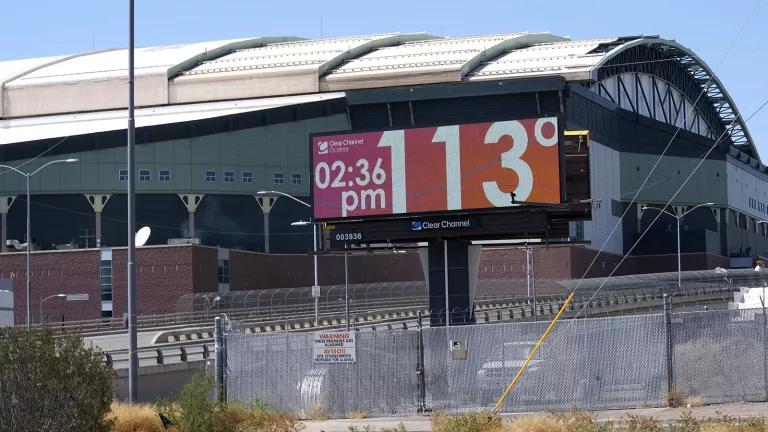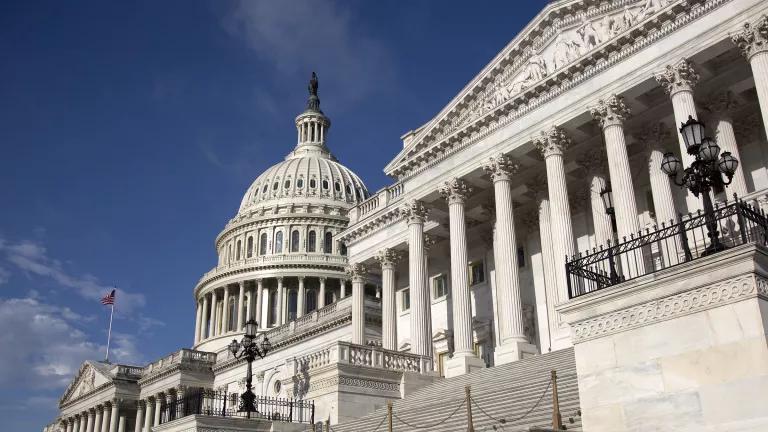Now's The Time to Strengthen & Modernize Public Health Data
Five ways to improve public health and strengthen the way we collect, share, and analyze data.

Registering to be tested for COVID-19 at the West Perrine Health Center in Miami, Florida, on May 28, 2020. Credit: Lynne Sladky/AP
In the face of complex threats to public health, decision making is only as good as the information it’s based on.
As COVID-19 spreads further and faster across the U.S., the pandemic is shining a harsh new light on the weaknesses of our national public health system. Our country’s struggle to respond effectively to this crisis is made clear by the staggering infection rate and death toll, case count, and overall transmission trajectory; no other developed country has performed as poorly. In order to respond to this public health crisis, and to the next one, and to the growing threats posed by climate change -- a persistent, overarching public health challenge -- we must do better. That includes treating health data systems like the public treasures they are.
A recent House Select Committee on the Climate Crisis report highlights the importance of access to complete, current, and integrated data sources. As this report notes, to address the climate crisis effectively, we need to ensure access to complete and accurate data on climate-related public health emergencies. We need to develop and deploy more easily actionable climate risk information that’s accessible and understandable.
There are parallels between our responses to the climate crisis and the coronavirus pandemic. Part of the problem with our situation today is the patchwork nature of U.S. public health data on disease testing and processing times, illness and hospitalization rates, and reporting of mortality statistics. Experts have noted that CDC’s traditional role as public health data keepers has recently been undermined. In 2020 we still lack modern, efficient, standardized, dynamic systems that are equipped to capture, integrate, and share data about complicated and evolving health threats across the entire country. Put simply, we are far behind where we ought to be. The coronavirus is spreading faster than our testing sites, public health laboratories, and reporting and contact tracing programs can keep up. As a result, our overall response to the problem is stifled and slowed-- to the continuing detriment of our health, safety, and the economy.
But it’s not just a coordination issue; our public information technology infrastructure is badly outdated and underfunded. For example, this year staffers at the U.S. Centers for Disease Control and Prevention (CDC) have been contending with a gushing stream of emailed spreadsheet attachments, DVDs, fax machine printouts, and phone calls from individual hospitals to track the rapid spread of a deadly virus-- rather than utilizing 21st century digital tools that would enable them to more efficiently track, analyze, and respond to the problem in real-time. Neglect of these systems is no longer an option.

Emergency Operations Center staff responding to the coronavirus crisis at CDC Headquarters in Atlanta, Georgia, on February 3, 2020. Credit: CDC
As we work to improve major data system challenges in the context of COVID-19, our country should also be mindful of another growing health crisis -- the one posed by climate change. The new House Select Committee on Climate Crisis Report identifies priorities for the U.S. response to climate change-- including the need to develop, fund, and maintain better systems for public data and health tracking. The report highlights the need to strengthen our routine disease surveillance systems to meet the array of climate-fueled health challenges that are only growing in scope and severity. By improving our country’s ability to collect and synthesize public health information, the 12 key pillars of the Select Committee’s plan can proceed on more solid footing.
Here’s five ways that we can improve public health by strengthening the way we collect, share, and analyze data:
1. Bolster CDC’s Climate and Health Resources
The climate and health program at the U.S. Centers for Disease Control and Prevention (CDC) leads the national response to prepare for climate change’s health challenges. Yet CDC’s climate-health work has been underfunded and politicized for years, and its data systems are outdated and poorly-resourced. The White House has even been further reducing CDC access to some data that is critical in keeping tabs on critical public health emergencies -- like the numbers of COVID-19 cases that hospitals are treating daily. CDC should return to its formerly prominent leadership role in the nation’s public health preparedness and response, for health emergencies that include pandemics and climate change.
CDC’s budget should be substantially increased to prioritize modernization of their data systems. With the budget to link and integrate its health data with other agencies’ environmental and social data systems, CDC would be empowered to build a 21st-century system to link climate change, environmental disruptions, and health.
2. Strengthen State-level Climate Preparedness
Currently, the CDC funds the Climate Ready States and Cities Initiative (CRSCI), which helps grantees from 16 states and two cities research, then prepare for climate change’s local effects. The Initiative uses a five-step “Building Resilience Against Climate Effects” (BRACE) framework to identify climate impacts in their communities and to strategize on minimizing their health harms. The community of CRSCI grantees are at the forefront of climate and health preparedness in the U.S. But CRSCI/BRACE only covers about one third of states and a handful of cities and tribes.
One solution that the report highlights is to expand CRSCI funding and the coordination of climate planning to all states plus more cities and tribes, protect data integrity and transparency, and develop accessible ways to make global climate change a local issue.
3. Integrate Climate and Health Tracking
Currently, anyone who attempts to study the links between climate change and human health at a local level is faced with a patchwork of incomplete, delayed, and sometimes unreliable data. CDC has a Climate & Health Data and Tools webpage that includes the Environmental Public Health Tracking Network. The Tracking Network offers online ways to compile and map environmental change and its health consequences, like heat stress emergency department visits, but from just 25 states and one city. Yet climate change is harming health all across the country. Climate-fueled extreme weather events are accelerating, like the terrible flooding in Michigan earlier this year, and the current heatwave searing the southwest. Emergency responders and public health agencies are faced with these double health threats. The Global Heat-Health Information Network (GHHIN) developed new guidance detailing how COVID-19, extreme heat, and air pollution health threats overlap, and ideas for launching more integrated responses.
Here in the U.S., we can better understand the scope of these problems when we direct funding and technology towards assembling more complete, integrated national environment-health data systems. Those systems can allow us to build a more complete, “whole fabric” understanding of climate-health effects, and put some special focus on understanding overlapping threats.
Take mapping, for example: NRDC has developed climate-health maps of the U.S. that detail how climate change is affecting health locally - right in our backyards. And CDC funds local public health research in Arizona on climate-health harms, including heat. In the last decade, annual heat-related deaths in Arizona have doubled, yet the greatest number of fatalities don’t always coincide with the hottest days. Why? As Arizona State University heat researcher Dr. David Hondula said of CDC’s climate-health program, “If additional funding existed, we could really dive in to answer this question.”
4. Improve Valuation of Health Costs
The current pandemic is imposing huge costs on the American public, including damage to health, jobs, businesses, and tax revenues. It’s also an expensive healthcare problem for those requiring medical treatment, at precisely the moment when many people are losing their jobs and access to employer-provided health insurance. Millions of people in this country routinely struggle to pay healthcare bills, but the mounting health costs of problems like those fueled by climate change have been largely ignored. We hear concerns about the costs of responding to public health threats, but much less about the costs of inaction— in terms of serious health problems and skyrocketing bills for medical care.
To fill this gap, the report recommends that the federal government act to improve financial forecasts of climate damages so that policymakers no longer heavily underestimate those risks. Improved estimates of the costs of public health problems can help to motivate stronger, more effective interventions addressing the underlying drivers of these problems.
5. Identify and Reduce Inequitable Health Burdens
As the current pandemic crisis has shown, inequitable burdens of many public health problems (including climate harms) are shouldered by marginalized communities, including communities of color and low-income populations. For example, a recent analysis of CDC data on COVID-19 revealed a hugely inequitable hospitalization rate and mortality burden on Latinos and Black Americans compared to national averages.
We must require and incorporate key sociodemographic data into our disease surveillance systems to identify communities that are suffering the most from these health threats. We also need to prioritize interventions to address inequities at their root causes and tailor public health interventions to reach different types of vulnerable groups (e.g., in occupational settings, nursing homes, prisons, and homeless shelters) rather than applying a one-size-fits-all approach. As the report points out, our country must recognize the urgent and continuing need to prioritize equity and support strong public health systems so that these efforts at the local, state, and federal level can better identify and ultimately reduce lingering disparities.

A temporary parking lot shelter set up for people experiencing homelessness, with spaces marked for social distancing, in Las Vegas, Nevada, on March 30, 2020. Credit: Steve Marcus/Reuters
Benefits of Strong Action
Each of these solutions will take time to plan and implement, but each will also pay off--in reduced human suffering, lower healthcare costs, and a more responsive, proactive public health system. In order to make change happen, it’s vital that our elected leaders support, fund, and defend public health experts and support their tools at the CDC rather than undermine or circumvent their expertise and analyses. Because in the face of complex threats to public health, decision making is only as good as the information it’s based on.




